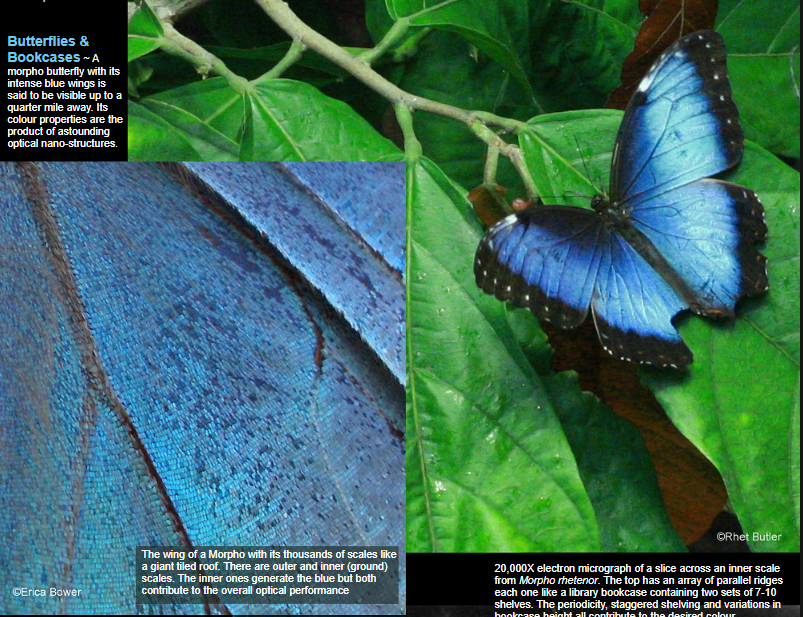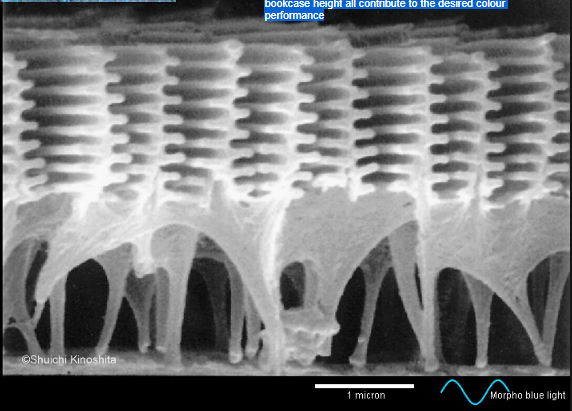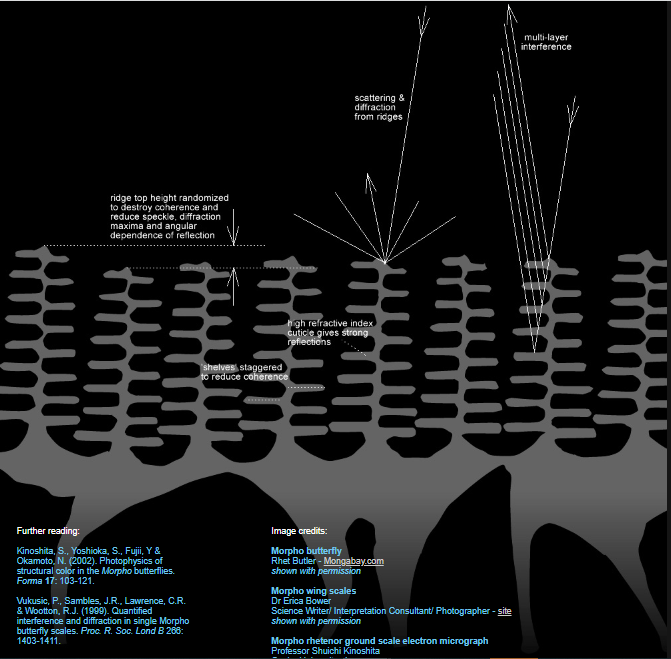Butterflies & bookcases
Butterflies & Bookcases: The Astonishing Optical Engineering of Morpho Butterflies
Morpho butterflies are renowned for their vibrant blue wings, which can be seen from a remarkable distance of up to a quarter mile away. But what gives these butterflies their intense color properties? The answer lies in their astounding optical nano-structures, which make them true marvels of nature's engineering.
The wings of a Morpho butterfly are covered with thousands of scales, resembling a giant tiled roof. These scales can be categorized into two types: outer scales and inner (ground) scales. While both types contribute to the overall optical performance of the wings, it is the inner scales that generate the brilliant blue color for which Morpho butterflies are famous.
To understand the complexity of the Morpho's color production, let's take a closer look at the inner scales under an electron microscope. What we discover is a world of intricate quasi-periodic structures that resemble an array of parallel ridges, similar to library bookcases. Each ridge consists of two sets of 7-10 shelves, carefully staggered and with random height variations. These nano-scale features are not accidental; they serve an optical purpose.
The pure color and high reflectivity of the Morpho's wings are primarily achieved through multi-layer interference. As light rays reflect from successive shelves, they undergo constructive and destructive interference, resulting in intense blue coloration. This effect can be compared to the stacked silicate layers that generate the blue color inside labradorite.
However, multi-layer interference alone is not sufficient to create the desired optical performance of the Morpho's wings. Without the staggered shelf positions and variations in bookcase height, the outgoing waves would retain coherence, leading to speckle, bright diffraction spots, and an undesirable angular dependence of the reflection. The Morpho's intricate nano-structures effectively destroy the coherence of the outgoing waves, broadening the angles over which the intense blue color is visible.
In addition to multi-layer interference and diffraction, the outer cover scale of the Morpho's wings plays a crucial role in further enhancing the optical performance. This scale diffuses incoming light and reduces the angular dependence of the blue reflection. It also scatters light, aiding in species differentiation. Furthermore, pigmentation in the lower part of the ground scale contributes to the brilliance of the interference-generated blue by reducing red and green light.
The optical sophistication of Morpho butterflies is truly impressive and serves as an excellent example of structural color. Unlike color derived from pigments, structural color arises from the complex nano-structures of a system. While not all butterflies exhibit such intricate optical engineering, structural color can also be found in feathers, beetles, fish scales, and even some plants. The study of these natural phenomena continues to inspire scientists and holds promise for future discoveries.
In conclusion, the intense blue coloration of Morpho butterflies is a result of their remarkable optical engineering. The intricate nano-structures of their wings, resembling staggered bookcases, create multi-layer interference and diffraction effects that produce a pure and highly reflective blue hue. These optical features allow Morpho butterflies to be recognized from great distances and may even play a role in long-distance signaling and mating. The study of such natural wonders opens up new avenues for scientific exploration and offers insights into the astonishing capabilities of nature's design.
Butterflies & Bookcases ~ A morpho butterfly with its intense blue wings is said to be visible up to a quarter mile away. Its colour properties are the product of astounding optical nano-structures.

The wing of a Morpho with its thousands of scales like a giant tiled roof. There are outer and inner (ground) scales. The inner ones generate the blue but both contribute to the overall optical performance
AtmosphericOptics
About - Submit Optics Picture of the Day Galleries Previous Next Today Subscribe to Features on RSS Feed
OpticsPOD - Optics Picture of the Day - OPOD | Today - Galleries - Submit Image - Atmospheric Optics
Further reading:
Kinoshita, S., Yoshioka, S., Fujii, Y & Okamoto, N. (2002). Photophysics of structural color in the Morpho butterflies. Forma 17: 103-121.
Vukusic, P., Sambles, J.R., Lawrence, C.R. & Wootton, R.J. (1999). Quantified interference and diffraction in single Morpho butterfly scales. Proc. R. Soc. Lond B 266: 1403-1411.
20,000X electron micrograph of a slice across an inner scale from Morpho rhetenor. The top has an array of parallel ridges each one like a library bookcase containing two sets of 7-10 shelves. The periodicity, staggered shelving and variations in bookcase height all contribute to the desired colour performance

To say that Morpho bright colours are from iridescence is a deceptive simplification for Morphos are triumphs of optical engineering.
Their wings are intensely bright with pure colour. Most importantly for long distance recognition, the intensity and colour is the same over a range of viewing angles and the light is polarized.
Simple interference from a single or multiple layers cannot achieve this. Look at a soap bubble or an oil film � its colours are not very bright nor pure and they alter with viewing direction.
How does Morpho do it?
The wings are covered with two layers of scales like an enormous tiled roof. In general the inner or ground scales produce most of the colour effects.
The ground scales are hollow and electron microscopy reveals intricate quasi-periodic structures. The top has a series of long parallel ridges each of which under high magnification is revealed as made up of a dual stack of parallel plates like two back to back library bookshelves. There are subtleties that are not accidental but have an optical purpose. The shelves on each side are staggered. The �bookcases� themselves have a careful random height variation.
All this is on a nano-scale. For example, the shelves of Morpho Didius are spaced 200nanometres apart in height and are 50-70nm thick. For comparison, �Morpho blue� light has a wavelength of 460nm. Each bookcase is about 2000 nm tall with 7-10 shelves. Books would not stand upright because all the shelves tilt 7-10� along their length.
The pure colour and high reflectivity come primarily from multi-layer interference as rays are reflected from successive shelves. Compare the effect with the blue colour from inside labradorite (earlier OPOD) generated by stacked silicate layers.
The Morpho blue is much more intense because the refractive index (~1.56) between the shelf cuticle and air is considerable and gives strong reflections.
Multilayer interference alone is not enough. It would produce a less than useful reflection varying in colour and intensity with changing direction. The staggered shelf positions and bookcase heights help destroy the coherence of the outgoing waves and reduce speckle, bright diffraction spots and the angular dependence.
Diffraction from the periodic spaced ridges (bookcases) also broadens the angles over which the intense blue is seen and adds polarisation that could be important for long distance signalling and mating.
The outer cover scale acts in some species (e.g. M.Didius) by diffusing the incoming light and further reducing the blue reflection angular dependence. It (and the tops of the bookcases) also scatteres light and helps differentiate between species.
Pigmentation plays a small role. The lower part of the ground scale can be melanin pigmented to reduce red and green light and thus increase the apparent brilliance of the interference generated blue.
In total, an impressive piece of evolutionary optical engineering. Also a prime example of structural colour where a system’s optical properties derive from a complex nano-structure rather than from pigments. Not all butterflies employ such heights of optical sophistication but there are others. We see structural colour too in feathers, beetles, fish scales and even some plants. The stuff of future OPODs!

Further reading:
Kinoshita, S., Yoshioka, S., Fujii, Y & Okamoto, N. (2002). Photophysics of structural color in the Morpho butterflies. Forma 17: 103-121.
Vukusic, P., Sambles, J.R., Lawrence, C.R. & Wootton, R.J. (1999). Quantified interference and diffraction in single Morpho butterfly scales. Proc. R. Soc. Lond B 266: 1403-1411.
Image credits:
Morpho butterfly
Rhet Butler - Mongabay.com
shown with permission
Morpho wing scales
Dr Erica Bower
Science Writer/ Interpretation Consultant/ Photographer - site
shown with permission
Morpho rhetenor ground scale electron micrograph
Professor Shuichi Kinoshita
Osaka University, Japan
shown with permission
Note: this article has been automatically converted from the old site and may not appear as intended. You can find the original article here.
Reference Atmospheric Optics
If you use any of the definitions, information, or data presented on Atmospheric Optics, please copy the link or reference below to properly credit us as the reference source. Thank you!
-
<a href="https://atoptics.co.uk/blog/butterflies-bookcases/">Butterflies & bookcases</a>
-
"Butterflies & bookcases". Atmospheric Optics. Accessed on April 25, 2024. https://atoptics.co.uk/blog/butterflies-bookcases/.
-
"Butterflies & bookcases". Atmospheric Optics, https://atoptics.co.uk/blog/butterflies-bookcases/. Accessed 25 April, 2024
-
Butterflies & bookcases. Atmospheric Optics. Retrieved from https://atoptics.co.uk/blog/butterflies-bookcases/.